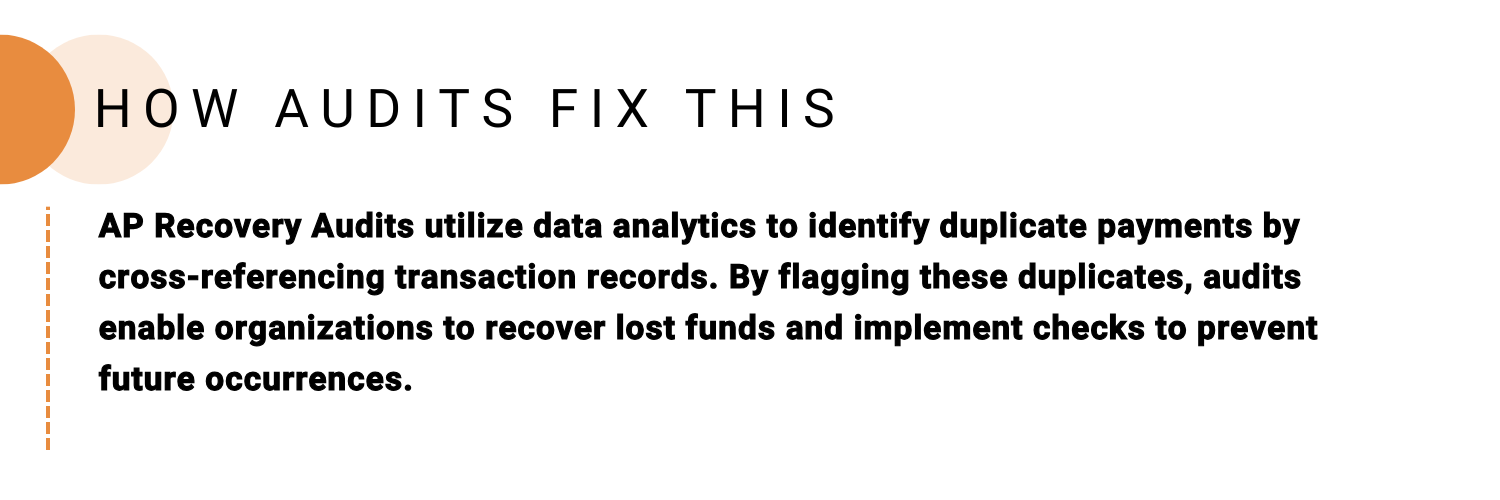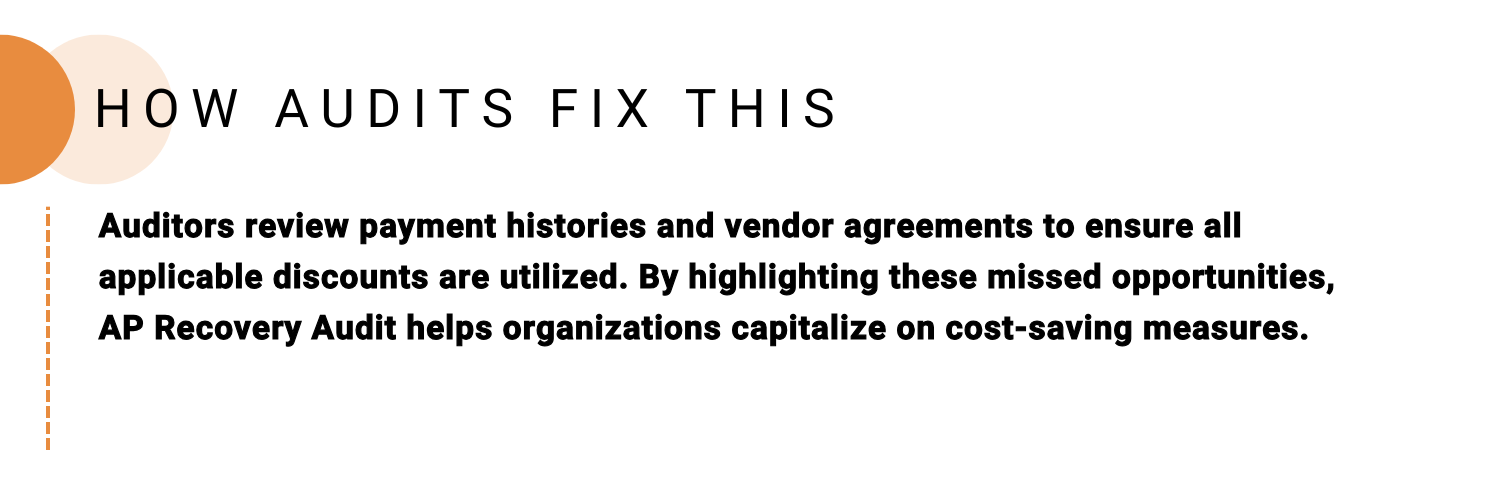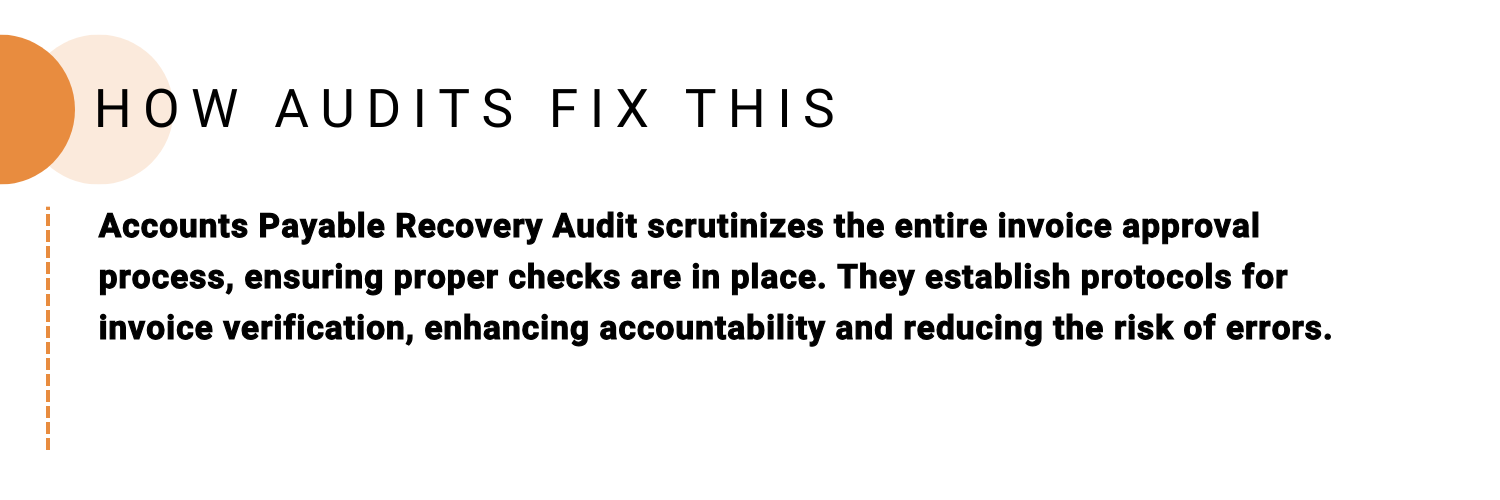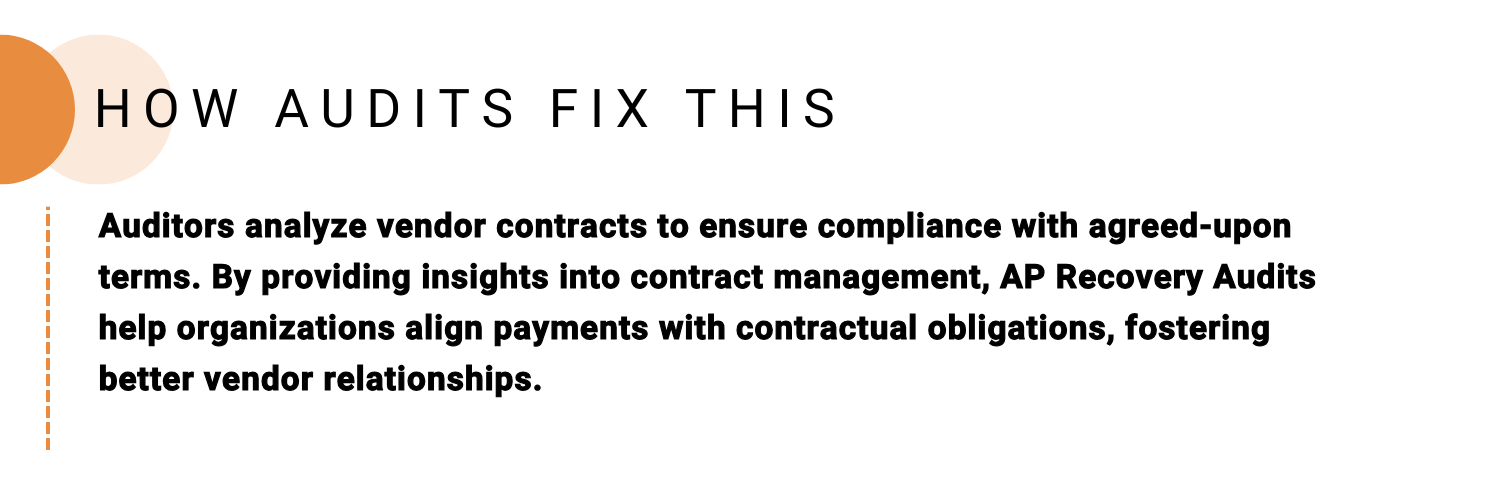Related Content
- How Accounting Leaders Evolve from Reactive Fixes to Proactive Prevention with Recovery Audits Powered by AI
- The Future CAO: How Artificial Intelligence is Redefining Accounting Leadership
- Where Should Accounting Leaders Focus Their Time and Efforts? Recovery Audits vs. Continuous Monitoring
- Mitigating the Loss of Profit in Retail: The Roles of Contract Compliance Audits and Artificial Intelligence in Preserving Profit Margins
- Driving EBITDA Growth Through AP Process Optimization and Revenue Recovery
- Preventing Overpayments: How AI-Driven Non-PO Invoice Management Supports AP Recovery Audits
- Uncovering the Most Frequent Leakage and Overpayment Scenarios in AP Recovery Audit
- Why CPG Giants are Turning to AP Recovery Audits to Fight Vendor Complexity and Price Discrepancies
- The Hidden Cost of Missed Credits in Retail AP: How Leading Brands Are Recovering Millions
- Manufacturing AP Recovery Audits: Mitigating Leakage from Freight, Tax, and Mosaic PO Structures
Financial accuracy is vital for every business. Despite sophisticated accounting systems, small errors—such as overpayments, duplicate invoices, or missed vendor discounts—can add up and lead to significant financial losses. This is where an Accounts Payable Recovery Audit steps in.
Historically, AP recovery audits were performed manually, with auditors meticulously going through records to identify discrepancies. However, in recent years, many providers have adopted cutting-edge AI technology to streamline this process. AI-powered audits can now quickly analyze vast amounts of transactional data, flagging anomalies with greater precision and efficiency than ever before.
An AP Recovery Audit helps businesses identify and recover lost revenue from unnoticed financial leakages in the Accounts Payable (AP) process. By auditing past transactions, companies can uncover errors, recover missed opportunities, and enhance their financial systems. The result? Immediate financial gains, improved processes, and stronger vendor relationships.
This blog serves as the ultimate guide for businesses looking to understand everything about AP Recovery Audits—from their benefits and best practices to common challenges and solutions. Whether you’re new to AP audits or seeking ways to improve your current process, we’ve covered everything you need to know to make informed decisions.
Why Should Companies Discover Accounts Payable Recovery Audit?
Accounts Payable (AP) processes are crucial to maintaining a company’s financial health, yet they often conceal hidden leakages like overpayments, missed discounts, or unclaimed credits. These aren’t always due to glaring errors but subtle misalignments across complex transactions.
For example, a manufacturing firm once uncovered through an Accounts Payable Recovery Audit that it had inadvertently made duplicate payments due to a miscommunication with vendors, recovering a significant six-figure sum. Missed early-payment discounts, another common issue, often seem small but accumulate rapidly, costing businesses substantial amounts.
AP Recovery Audits help companies recover these financial losses while also revealing operational inefficiencies. Beyond recovering lost revenue, these audits provide actionable insights that enhance compliance, streamline AP operations, and reduce future errors. In a competitive market where financial accuracy is vital, AP Recovery Audits enable businesses to optimize payment processes and improve long-term financial stability.
Curious about your savings potential? Explore overpayment and leakage scenarios tailored to your business.Calculate your savings and download the report
The Core Benefits of an AP Recovery Audit
-
1. Recovery of Lost Revenue
Accounts Payable Recovery Audit can reclaim significant amounts lost due to overpayments or missed discounts. For example, a retail chain discovered it had overpaid vendors by $300,000 through duplicate invoices. This immediate recovery can significantly enhance a company's cash flow.
-
2. Strengthened Vendor Relationships
Accurate and timely payments foster trust with vendors. After an audit, a manufacturing firm that improved its AP processes reported enhanced relationships with suppliers, leading to better terms and more favorable pricing agreements.
-
3. Optimization of Financial Processes
Audits reveal inefficiencies within the AP workflow. A healthcare organization streamlined its invoice processing, reducing approval times by 40% after identifying redundancies during an audit. This optimization allows finance teams to focus on strategic initiatives rather than administrative tasks.
-
4. Reduced Risk of Fraud and Mismanagement
AP Recovery Audit helps identify vulnerabilities in payment processes. For instance, an audit at a large corporation uncovered potential fraud schemes, prompting the implementation of stronger internal controls to safeguard against future risks.
-
5. Actionable Data-Driven Insights
The insights gained from an Accounts Payable Recovery Audit can guide future financial decisions. Companies can leverage audit findings to implement process improvements, ultimately leading to better financial health. For example, a tech company used audit data to renegotiate vendor contracts, resulting in a 15% reduction in costs.
Pro Tip: Regularly conducting AP Recovery Audits not only helps recover lost revenue but also establishes a proactive approach to managing accounts payable. By integrating audits into the financial calendar, companies can continually optimize processes and safeguard against future errors.
How an Accounts Payable Recovery Audit Works: A Step-by-Step Guide
-
1. Collection and Mapping of Data
The process begins with the collection of all relevant financial data, including invoices, payment records, and vendor contracts. This comprehensive mapping ensures no crucial information is overlooked.
-
2. Identification of Claims
Auditors analyze the collected data to identify claims for recovery, such as overpayments and missed discounts. This step involves meticulous scrutiny to pinpoint discrepancies that may have occurred over time.
-
3. Claims Approval
Once claims are identified, they undergo a review process for approval. This step ensures that all findings are validated and ready for action before recovery efforts commence.
-
4. Recover Overpayment from Vendor
After approval, efforts are initiated to recover identified overpayments from vendors. This may involve negotiations and clear communication to rectify payment errors and secure refunds.
-
4. Financial Impact: Maximizing Profitability Through Effective Recovery
The cumulative effect of recovering overpayments and optimizing processes can lead to significant improvements in the company's profitability and loss management. This step highlights the potential financial benefits of conducting AP Recovery Audits.
.png?width=1053&height=351&name=Copy%20of%20blog%207%20creative%201%20(1).png)
Key Problems and Challenges Addressed by AP Recovery Audit
Accounts Payable Recovery Audit are essential for identifying and addressing several common issues that can lead to financial losses within an organization. Here are some key challenges and how these audits effectively mitigate them:
-
1. Duplicate Payments
One of the most frequent issues faced by businesses is the occurrence of duplicate payments for the same invoice. For example, a company might inadvertently pay an invoice twice due to processing errors or lack of communication between departments. An AP Recovery Audit can identify these duplicates, allowing the company to recover funds and improve internal controls.
Implementing a centralized payment processing system can help reduce the risk of duplicates in the future
-
2. Missed Invoices
Companies often overlook invoices, especially when dealing with a large volume of transactions. This can lead to strained vendor relationships and missed payment discounts. Accounts Payable Recovery Audit helps identify any missed invoices, enabling businesses to settle accounts promptly and take advantage of early payment discounts.
Regularly review accounts payable reports to ensure all invoices are accounted for.
-
3. Pricing Discrepancies
Variations between invoiced amounts and agreed-upon contract prices can result in overpayments. For instance, if a vendor increases their prices without prior notification, an audit can catch these discrepancies before they impact the bottom line.
Maintain a detailed contract management system to ensure all pricing agreements are accessible and regularly reviewed.
-
4. Miscommunication Between Departments
Inefficient communication between the Accounts Payable and Procurement departments can lead to errors in order fulfillment and invoice processing. AP Recovery Audit can reveal communication gaps and facilitate better collaboration between teams, ultimately leading to more accurate payments.
Establish regular meetings between AP and Procurement teams to discuss issues and share updates.
-
5. Vendor Contract Management Failures
Lack of oversight in vendor contracts can result in non-compliance with payment terms and missed savings opportunities. Accounts Payable Recovery Audit can help identify where companies are not adhering to contract terms, leading to more strategic vendor management.
Use technology to track contract compliance and set reminders for key contract milestones.
-
6. Complex International Transactions
Businesses that deal with international vendors often face challenges related to currency conversions, tariffs, and varying payment terms. AP Recovery Audits can help navigate these complexities by ensuring that all payments align with contract stipulations and regulations.
Consider consulting with experts in international finance to ensure compliance and accuracy.
-
7. Unauthorized Purchases and Fraud Detection
Unauthorized purchases can be detrimental to an organization's finances. Accounts Payable Recovery Audit can help detect suspicious transactions and identify potential fraud. By scrutinizing transaction patterns, auditors can pinpoint anomalies that warrant further investigation.
Implement strict approval processes for all purchases to minimize the risk of unauthorized spending.
Best Practices for Conducting an Accounts Payable Recovery Audit
Conducting an effective AP Recovery Audit requires careful planning and execution. Here are some best practices that can guide businesses in maximizing the benefits of their audits:
-
1. Preparation and Planning
Before starting an audit, it's essential to define the objectives and scope. Gather relevant documents, such as invoices, contracts, and payment histories. Create a timeline and assign roles to team members to ensure everyone understands their responsibilities. This structured approach helps streamline the audit process and enhances efficiency.
Example: A mid-sized manufacturing company that prepared thoroughly for its audit found that having a clear plan allowed it to complete the audit two weeks ahead of schedule, resulting in quicker fund recovery.
-
2. Data Accuracy and Accessibility
Ensure that all financial data is accurate and easily accessible. Disorganized records can lead to missed discrepancies and hinder the auditing process. To maintain data integrity, regularly update financial systems and conduct internal checks.
Tip: Implement a document management system to categorize and store invoices, contracts, and other critical documents systematically.
-
3. Collaboration Between Teams
Foster collaboration between the Accounts Payable, Procurement, and Finance departments. Open lines of communication can help clarify discrepancies and provide insights into potential issues. Regular meetings can facilitate a shared understanding of processes and promote accountability.
Example: By establishing bi-weekly meetings between the AP and Procurement teams, a technology firm significantly reduced invoice processing errors and enhanced its audit readiness.
-
4. Utilizing Technology
Leverage automated tools and software that specialize in Accounts Payable Recovery Audit. These technologies can analyze large datasets quickly, identify patterns, and flag discrepancies that might otherwise go unnoticed. Automation also reduces the manual workload, allowing teams to focus on strategic decision-making.
Tip: Invest in a robust audit management tool that integrates seamlessly with existing financial systems for real-time data analysis.
-
5. Conducting Regular Audits
Instead of waiting for an annual audit, conduct regular reviews to catch discrepancies early. This proactive approach can prevent the accumulation of errors and promote a culture of financial accountability within the organization.
Example: A retail company that implemented quarterly audits discovered ongoing discrepancies, allowing them to recover funds continuously rather than in one lump sum.
-
6. Training and Education
Ensure that staff involved in the AP process are well-trained on best practices and the importance of accuracy. Regular training sessions can enhance their skills and awareness, reducing the likelihood of errors.
Tip: Create an onboarding program for new employees focused on AP processes, compliance, and the significance of audits.
Challenges Companies Face During AP Recovery Audit
While Accounts Payable Recovery Audit can yield significant benefits, companies often encounter various challenges that can complicate the process. Here are some common hurdles and how they can be addressed:
-
1. Resistance to Change
Employees may resist changes to established processes, fearing that audits will uncover their mistakes or create additional work. This resistance can hinder the effectiveness of the audit and lead to a lack of cooperation.
Solution: Communicate the benefits of the audit, emphasizing how it contributes to financial health and operational efficiency. Involve employees in the process to foster a sense of ownership and encourage a collaborative approach.
-
2. Disparate Data Systems
Many organizations use multiple systems for managing financial data, which can lead to inconsistencies and gaps in information. Disparate data systems can make it challenging to conduct a comprehensive audit.
Solution: Invest in integrated financial management software that consolidates data from various sources. This ensures that all relevant information is available in one place, simplifying the auditing process.
-
3. Balancing Cost and Value
Companies often struggle to justify the costs associated with conducting an AP Recovery Audit. They may worry that the investment will not yield sufficient returns.
Solution: Analyze potential savings from past audits to build a business case for future audits. Present data that illustrates the ROI of conducting regular audits and how they can lead to substantial recoveries.
-
4. Data Privacy and Compliance
Handling sensitive financial information raises concerns about data privacy and compliance with regulations. Companies must ensure that their auditing processes align with relevant laws and best practices.
Solution: Work with compliance experts to develop robust data handling policies. Ensure that all team members involved in the audit are trained on data privacy regulations and the importance of safeguarding sensitive information.
-
5. Limited Resources
Smaller companies may lack the necessary resources—such as time, personnel, or budget—to conduct thorough audits. This can result in incomplete assessments and missed recovery opportunities.
Solution: Consider outsourcing the audit to a specialized firm if in-house resources are limited. This allows companies to leverage external expertise without overburdening internal teams.
-
6 Inadequate Training
Without proper training, employees may not understand how to identify discrepancies or the significance of the audit process. This can lead to missed opportunities for recovery.
Solution: Provide comprehensive training programs focused on AP processes and the specific objectives of the audit. Empowering employees with knowledge enhances their ability to contribute effectively to the audit.
By acknowledging these challenges and implementing strategic solutions, companies can enhance the effectiveness of their Accounts Payable Recovery Audit and maximize their financial recoveries.
Perennial Misconceptions About Accounts Payable Recovery Audit
Despite the clear benefits of AP Recovery Audits, several misconceptions persist that can deter businesses from pursuing them. Understanding these myths can help organizations make informed decisions regarding their financial practices.
-
1. “We Don’t Need It; Our Systems Are Perfect.”
Many companies believe their financial systems are error-proof, leading them to dismiss the need for audits. However, no system is infallible, and even the most sophisticated software can miss errors or discrepancies.
Example: A large retail chain that relied solely on its automated payment system discovered significant overpayments during an audit, revealing gaps in its controls that the software had overlooked.
-
2. “Audits Are Time-Consuming and Disruptive.”
Some organizations fear that the audit process will disrupt daily operations and consume excessive time. However, with proper planning and the use of technology, audits can be streamlined and integrated into regular business operations.
Tip: Schedule audits during quieter periods or use an automated tool
-
3. “Only Large Companies Benefit from Audits.”
There’s a misconception that Accounts Payable Recovery Audit are only valuable for large corporations with extensive transactions. In reality, small and medium-sized enterprises (SMEs) can gain substantial benefits, as they often have less formalized processes and may be more vulnerable to errors.
Example: An SME in the manufacturing sector conducted an audit and recovered thousands in overpayments, highlighting that smaller companies can achieve significant financial improvements through regular audits.
-
4. “Audits Are Only About Finding Overpayments.”
Many people view audits as a tool solely for identifying overpayments. However, the AP Recovery Audit also reveals inefficiencies, compliance issues, and opportunities for process improvements that can enhance overall financial management.
Example: A hospital could discover that they are paying higher prices for supplies due to outdated contracts or missed volume discount thresholds. By addressing these inefficiencies, the hospital can streamline procurement processes, ensure compliance, and potentially save millions in annual expenses, beyond just recovering overpayments.
-
5. “Audits Are Too Expensive.”
The belief that audits come with prohibitive costs often deters companies from pursuing them. However, the potential savings from recovering lost funds typically far outweigh the costs of the audit itself.
Solution: Develop a clear business case that outlines potential recoveries based on past performance, demonstrating that audits can be a worthwhile investment.
-
6. “Once We Do an Audit, We’re Set.”
Some organizations think that conducting a single audit is sufficient for long-term financial health. In reality, regular audits are necessary to continually monitor processes and identify ongoing issues.
Tip: Establish a routine audit schedule to ensure ongoing oversight and recovery of potential losses.
Real-World Scenarios: How AP Recovery Audits Have Transformed Companies
Accounts Payable Recovery Audit has proven transformative for various organizations, enabling them to recover lost revenue and improve financial processes. Here are some real-world scenarios illustrating their impact:
-
1. Scenario: SME in Retail
An SME in the retail sector was skeptical about the value of an AP Recovery Audit due to its limited resources. However, after a comprehensive audit, the company discovered it had missed early payment discounts worth $100,000. The audit findings prompted the company to invest in training for its AP team and upgrade its invoice management system. The ongoing benefits included not only recovering missed discounts but also fostering a proactive culture that prioritized financial accuracy.
-
2. Scenario: Non-Profit Organization
A non-profit organization faced challenges in managing its finances effectively. An Accounts Payable Recovery Audit uncovered discrepancies related to grant funding and vendor payments, allowing the organization to recover approximately $150,000 in misallocated funds. This recovery enabled the non-profit to reinvest in its programs and improve service delivery. The audit also prompted a review of financial processes, resulting in better compliance and transparency with stakeholders.
.png?width=620&height=708&name=Copy%20of%20blog%207%20creative%20(2).png)
How to Choose the Right Accounts Payable Recovery Audit Provider
Selecting the right AP Recovery Audit provider is crucial for maximizing the benefits of the audit process. Here are key considerations and steps to ensure you make an informed decision:
-
1. Assessing Industry Expertise
Look for providers with a proven track record in your industry. Different sectors may have unique financial practices and challenges. A provider experienced in your specific industry will understand the nuances of your AP processes and can tailor their approach accordingly.
Example: A provider with extensive experience in the retail sector may be more adept at addressing issues related to seasonal vendor contracts and promotional discounts than a generalist firm.
-
2. Evaluating Transparency and Reporting
A good provider should be transparent about their methodologies, fees, and the expected outcomes of the audit. Look for firms that offer detailed reporting that clearly outlines findings, recovery recommendations, and action plans.
Tip: Ask potential providers for samples of their reports to gauge the clarity and depth of their analysis. This can help ensure you receive valuable insights rather than just a list of recoveries.
-
3. Understanding the Technology Used
Inquire about the technology and tools the provider uses to conduct audits. Advanced data analytics and automation can significantly enhance the accuracy and efficiency of the audit process. Providers that leverage technology will often yield better results.
Tip: Request demonstrations of the technology used by the provider to see how it can identify discrepancies and optimize your AP processes.
-
4. Support and Collaboration
Choose a provider that emphasizes collaboration and ongoing support throughout the audit process. An ideal partner should work closely with your internal teams, facilitating knowledge transfer and ensuring that the audit process aligns with your business goals.
Tip: Look for providers that offer post-audit support, helping you implement recommendations and develop strategies to prevent future errors.
-
5. Evaluating Cost vs. Value
While cost is an important factor, it should not be the sole determinant in your decision. Consider the potential value the provider can deliver through recoveries and process improvements. A higher upfront cost may be justified if the provider can demonstrate a strong potential for significant financial recoveries.
Example: If a provider charges a higher fee but has a reputation for recovering substantial amounts, the overall ROI could make it worthwhile.
-
6. Client References and Case Studies
Request references from previous clients and review case studies that demonstrate the provider's success in recovering funds and improving AP processes. This firsthand feedback can provide valuable insights into the provider's effectiveness and reliability.
Tip: Reach out to clients in similar industries or with similar challenges to gauge how well the provider addressed their specific needs.
By carefully considering these factors, companies can choose an Accounts Payable Recovery Audit provider that aligns with their objectives and drives meaningful financial improvements.
.png?width=592&height=676&name=Copy%20of%20blog%207%20creative%20(3).png)
Want to see AI in action for your AP process? Speak with an AP expert to discover how we can transform your accounts
payable operations.
The Role of Technology in Modern Accounts Payable Recovery Audit
Technology has become a cornerstone of modern AP Recovery Audits, significantly enhancing their effectiveness and efficiency. Here’s how technology plays a vital role in the auditing process:
-
1. Data Analytics and Pattern Recognition
Advanced data analytics tools enable auditors to sift through vast amounts of transactional data quickly, identifying patterns that may indicate discrepancies or inefficiencies. These tools can analyze payment histories, vendor contracts, and invoices to detect anomalies that human auditors might overlook.
Example: An auditing firm utilized data analytics to uncover a pattern of duplicate payments in a retail client's transaction history. By analyzing payment records against vendor contracts, they identified instances where the same invoice was paid multiple times due to a data entry error, resulting in significant recoveries for the retailer.
-
2. Automation of Processes
Automation streamlines the audit process by handling repetitive tasks such as data entry and invoice matching. This not only reduces the time required for audits but also minimizes the risk of human error, leading to more accurate outcomes.
Pro Tip: Implementing automated workflows can facilitate ongoing monitoring, allowing for real-time identification of discrepancies rather than relying solely on periodic audits.
-
3. Machine Learning and AI
Machine learning algorithms can continuously improve audit accuracy by learning from past audits. These technologies can adapt to new patterns and emerging risks, making the audit process more responsive to changing business environments.
Example: In the manufacturing sector, a company implemented machine learning algorithms to analyze production and procurement data. The system identified patterns that indicated potential supply chain disruptions, such as rising costs for certain materials. By forecasting these trends, the manufacturer could take proactive measures, such as renegotiating contracts or diversifying suppliers, ultimately reducing the risk of costly delays and ensuring smoother operations.
-
4. Integration with Financial Systems
Modern Accounts Payable Recovery Audit solutions often integrate seamlessly with existing financial and ERP systems, providing a holistic view of the organization’s financial landscape. This integration allows auditors to access relevant data quickly and efficiently, enhancing the depth of analysis.
Example: In the healthcare sector, a large hospital integrated its AP audit software with its ERP and patient billing systems. This integration enabled the hospital to efficiently track payments to suppliers and ensure compliance with contractual obligations. As a result, they streamlined data collection identified duplicate payments for medical supplies and services, and improved the accuracy of their financial reports, ultimately reducing unnecessary expenditures.
-
5. Enhanced Reporting and Visualization
Technology enables more effective reporting and visualization of audit findings. Interactive dashboards can present data in a user-friendly manner, making it easier for stakeholders to understand key insights and recommendations.
Pro Tip: Choose a provider that offers intuitive reporting tools, allowing your team to easily digest audit findings and implement necessary changes.
-
6. Improving Compliance and Risk Management
Technological solutions can enhance compliance with regulatory requirements by ensuring that all transactions are tracked and documented accurately. This reduces the risk of financial mismanagement and enhances the organization’s credibility with stakeholders.
Pro Tip: Regularly update your technology tools to stay compliant with changing regulations and industry standards, ensuring your audit processes remain effective.
Common Mistakes in AP Processes and How AP Recovery Audit Fixes Them
Accounts Payable processes are essential for maintaining a company's financial health, but they are often fraught with errors and inefficiencies. Here are some common mistakes made in AP processes and how Accounts Payable Recovery Audit can effectively address them:
-
1. Duplicate Payments
One of the most prevalent mistakes in AP is the processing of duplicate payments, often due to errors in data entry or lack of communication between departments. These overpayments can lead to significant financial losses.

-
2. Missed Vendor Discounts
Companies frequently overlook early payment discounts offered by vendors due to poor tracking of payment terms. This oversight can result in substantial savings.

-
3. Inadequate Invoice Verification
Inconsistent or insufficient verification of invoices can lead to payments for goods or services not received, resulting in financial discrepancies.

-
4. Lack of Visibility into Vendor Contracts
Many organizations struggle with managing vendor contracts, leading to misunderstandings about payment terms and obligations. This lack of visibility can result in compliance issues and financial losses.

-
5. Ignoring Internal Controls
Weak internal controls can expose organizations to fraud and mismanagement. With proper oversight, unauthorized purchases may be noticed.

Best Practices to Avoid AP Process Leakages with AP Recovery Audit
To maximize the benefits of Accounts Payable Recovery Audit and minimize potential leakages in the accounts payable process, organizations should adopt the following best practices:
-
1. Regular Audits
Conducting AP audits regularly helps identify issues before they escalate. Frequent audits can uncover discrepancies and inefficiencies, allowing organizations to take corrective action proactively.
Pro Tip: Schedule audits quarterly or bi-annually to ensure continuous monitoring and improvement of your AP processes.
-
2. Implement Automated Solutions
Utilizing automated AP solutions can reduce the risk of human error and streamline processes. Automation can assist with invoice matching, payment approvals, and data entry, leading to more efficient operations.
Example: An organization that implemented automated invoicing saw a 30% reduction in processing time and a significant decrease in duplicate payments.
-
3. Establish Clear Approval Processes
Having a defined approval hierarchy and process for invoices helps maintain accountability and transparency in the AP function. This reduces the risk of unauthorized payments and enhances financial control.
Pro Tip: Utilize a digital workflow tool to manage approvals, ensuring that every invoice passes through the appropriate channels for verification.
-
4. Monitor Key Metrics
Establishing KPIs for AP processes can provide valuable insights into performance and areas for improvement. Metrics such as payment cycle time, invoice accuracy, and discount capture rates can highlight potential leakages.
Example: A company that monitored its discount capture rate noticed a 15% increase in savings after identifying and addressing missed discount opportunities.
-
5. Utilize Accounts Payable Recovery Audit for Continuous Improvement
Leverage the insights gained from AP Recovery Audits to inform future practices. Use the findings to develop strategies for process enhancements, training needs, and technology upgrades.
Pro Tip: Conduct a post-audit review meeting to discuss lessons learned and establish actionable plans for continuous improvement.
By implementing these best practices, organizations can significantly reduce the risk of AP process leakages and enhance the overall effectiveness of their accounts payable operations, leading to better financial health and stronger vendor relationships.

Conclusion
Accounts Payable Recovery Audits are essential for any business looking to get a handle on its finances and improve overall efficiency. Throughout this guide, we've explored why these audits matter, the benefits they bring, and how they can help solve common problems in accounts payable.
By understanding how AP Recovery Audits work, companies can uncover significant savings and build better relationships with their vendors. It’s all about spotting discrepancies early and putting best practices in place to avoid them in the future. Open communication and regular audits can make a real difference in managing your financial processes.
Looking ahead, the future of Accounts Payable Recovery Audit is promising, especially with advancements in technology like automation and AI. These tools can streamline operations even more, helping businesses recover lost funds and operate more smoothly.
In the end, investing in AP Recovery Audit isn’t just about recouping money; it’s about optimizing your financial processes and ensuring your business is ready for whatever comes next. As you consider your Accounts Payable Recovery Audit journey, think about partnering with experts who can guide you through the process and help you achieve lasting financial success!
Take the next step to recover your hidden savings. Request a Demo and see how AI powers smarter AP processes.
Frequently Asked Questions
Common tools include data analytics software, robotic process automation (RPA), and machine learning platforms that enhance the accuracy and efficiency of audits.
Yes, by identifying overpayments and inefficiencies, Accounts Payable Recovery Audit can improve cash flow, allowing businesses to allocate funds more effectively and reduce outstanding liabilities.
Employee engagement is crucial; fostering a culture of transparency and accountability can help identify discrepancies early and support the overall audit process.
Yes, many organizations offer training programs that focus on compliance, best practices, and the use of technology in auditing processes to enhance team capabilities.
Small businesses can start by establishing clear processes, using affordable audit tools, and possibly partnering with audit firms that specialize in serving smaller organizations.
Absolutely! Audits can uncover inefficiencies in processes, suggest better vendor terms, and highlight areas for cost reduction that may not be immediately obvious.
AP Recovery Audits align with business strategy by promoting financial health, optimizing operational efficiency, and fostering stronger vendor relationships, all of which support long-term growth objectives.
Regulatory changes can necessitate updates in compliance procedures and audit methodologies, making it important for organizations to stay informed and adapt their practices accordingly.
Success can be measured through metrics such as the amount of recovered funds, reduction in processing times, improved accuracy in financial reporting, and enhanced vendor satisfaction.
Start small by conducting pilot audits, engage with experienced auditors or consultants, and prioritize building a culture of compliance and transparency within your finance team.


